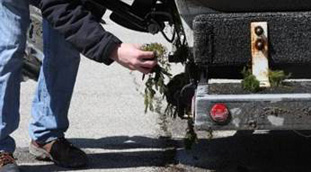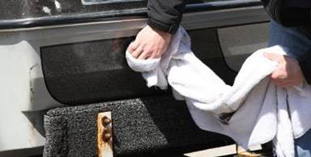 Anglers: Help stop the spread of invasive species!
Anglers: Help stop the spread of invasive species!
Aquatic invasive species (AIS), like zebra and quagga mussels, round goby, and the fish disease VHS, can reduce or eliminate native species in local waters, making fishing for lunker smallmouth or a trophy walleye more difficult. Invasive plants can also overgrow and choke waterways, which degrades fish habitat and impedes your ability to boat and fish. Preventing the spread of AIS is essential to reducing environmental impacts and economic losses and also to preserving our waters so that we can fish and boat for many years to come.
Unfortunately, AIS are easily transported by the equipment used by anglers, quite unintentionally and often unnoticed. AIS can be spread from one infested waterbody to another when they stick to boats, trailers, waders, and fishing gear, or when they hitch a ride in bilge, live well, or bait bucket water. If you boat or fish in Illinois' lakes and rivers, you could potentially contribute to the spread of aquatic invasive species.
But not all bodies of water are infested with AIS, and with your help, anglers can help to stop the spread of AIS. So, how can you help prevent the spread of AIS? It's simple: Be a Hero—Transport Zero™. Just a few simple steps – Remove, Drain, Dry – can make a big difference in keeping Illinois waters free from AIS.
Remove, Drain, Dry. Every time.
Before you leave a body of water, ALWAYS do the following:

Photo by Anjanette Riley, Illinois-Indiana Sea Grant
REMOVE plants, animals, and mud from all equipment.
Mud and plant fragments, like the Eurasian watermilfoil covering this trailer, can also hide AIS too small to be seen with the naked eye.

Photo by Anjanette Riley, Illinois-Indiana Sea Grant
DRAIN all water from your boat and gear.
Boaters should ensure plugs are pulled from bilge and live wells before leaving a waterway.
Bait bucket water should be drained on land.

Photo by Anjanette Riley, Illinois-Indiana Sea Grant
DRY everything thoroughly with a towel.
All equipment that comes into contact with water should be wiped off and dried with quick-dry towel.
If possible, dry everything for five days before entering new waters.
CLEAN other equipment as necessary:
- Waders and boots should be scrubbed and rinsed with tap or well water.
- If possible, use hot (<40°C or 104°F) or high-pressure water to clean your equipment. Using a car wash for your boat and trailer is a great alternative.
- Full-strength white vinegar or a solution of ¼ cup bleach per gallon of water can be used to disinfect equipment and confined spaces like live wells.
 OTHER TIPS:
OTHER TIPS:
Avoid the use of felt-soled waders and footwear to further reduce the risk of spreading AIS.
Unwanted bait should always be disposed of in the trash. Give your unused bait to a friend or freeze for cut bait if possible. Never release plants, fish or animals into a body of water unless they came out of that body of water.



